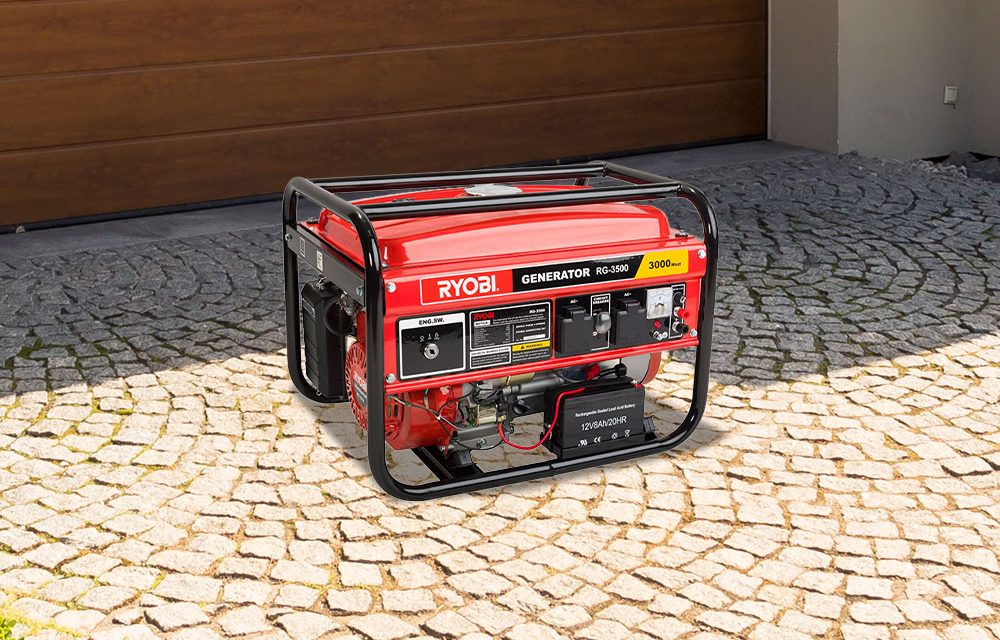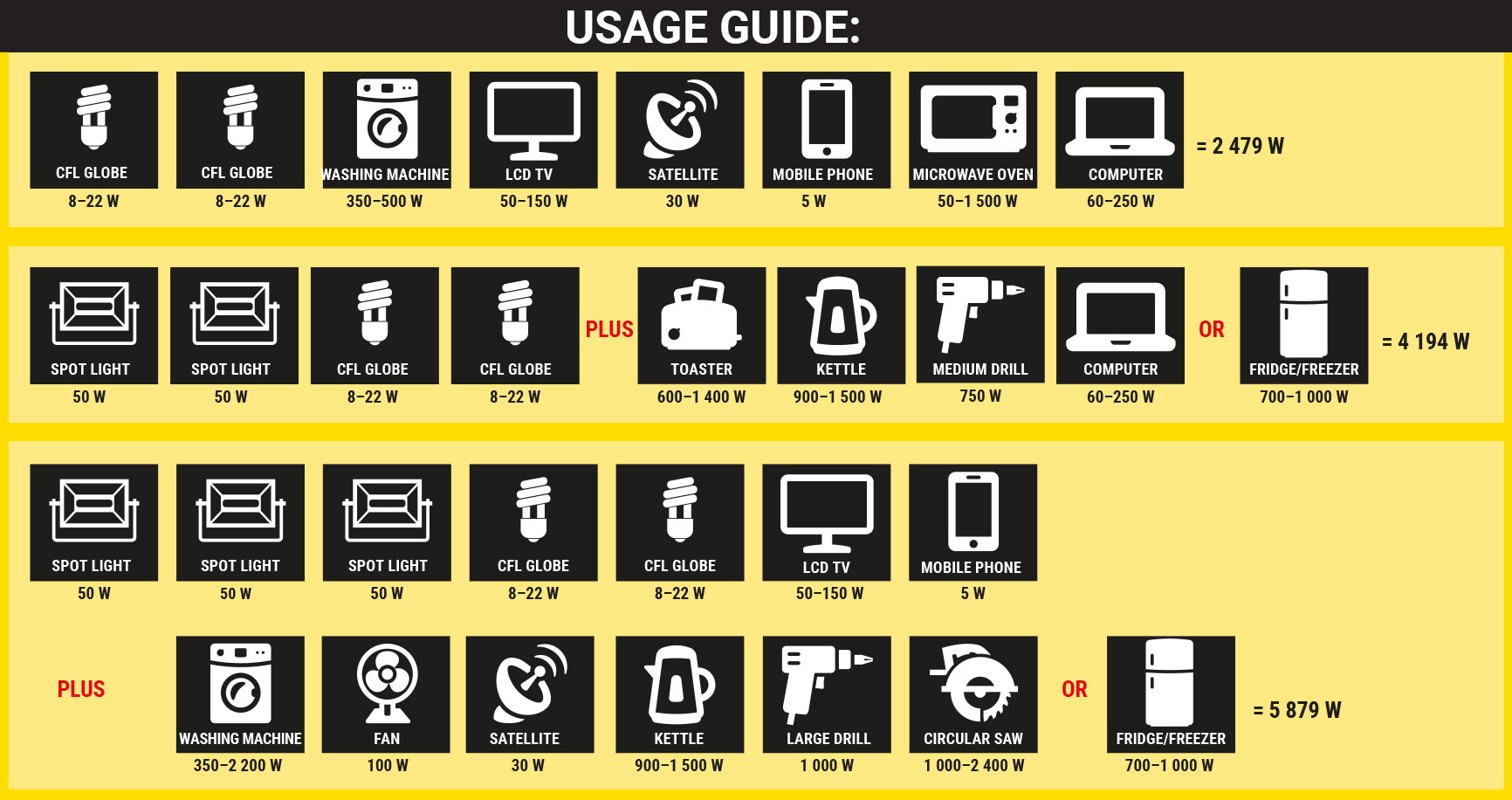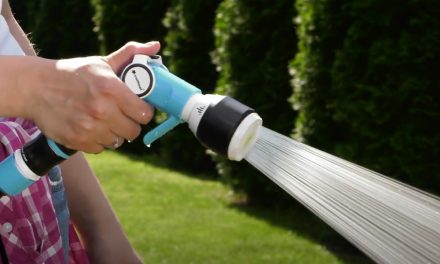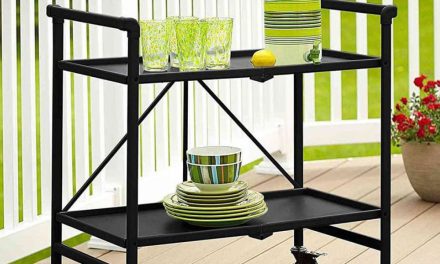Need to generate your own power? Let’s have a look at the available options and the features and benefits of each.
Inverters
Modified sine wave power inverter benefits:
- Silent
- Wide input voltage range, suitable for home or office
- Designed for indoor use
- Overload and short circuit protected
- Built-in intelligent battery/batteries
- Portable
- Automatic mains to battery switchover
- LCD display for comprehensive information
Calculating power consumption:
How to work out consumption requirements:
Sum of Device Watts ÷ 1000 = Kilowatts (kW)
Volts (V) = Always 230 V (Std. in S.A.)
Watts (W) = Amps (A) x Volts (V)
Amps (A) = Watts (W) ÷ Volts (V)
Remember:
Electric motors require a minimum power source of up to 3x their rating to start! (Add any “start-up” watts to the total sum of your consumption requirements.)
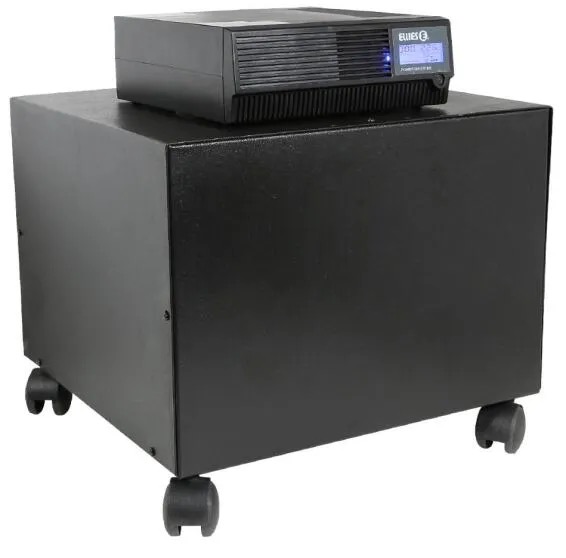
We sell the following:
- Separate 102 Amp Deep Cycle Battery
- Stand-alone inverter unit (720 W and 1 440 W options)
- 720 W inverter + one battery in mobile trolley (with wheels)
- 1 440 W inverter unit + 2 batteries in mobile trolley (with wheels)
Approximate running times
| Power | Capacity | Load |
|---|---|---|
| 720 W | 4-hour runtime at 60–80% (less than 570 W) | 8-hour runtime at 50% or less (360 W) |
| 1 440 W | 4-hour runtime at 60–80 % (less than 1 150 W) | 8-hour runtime at 50% or less (720 W) |
Important Considerations
- Deep cycle batteries go into deep sleep if they stand for a long time. Ensure that they are fully charged before using new batteries for the first time.
- To maintain the lifespan of the batteries, they must be recharged every 3 months. Do this by running the inverter until the battery is completely flat and then recharge it fully.
- The ambient temperature (the average air temperature where your inverter is stored) affects both performance and battery longevity. The ideal temperature is 25 degrees Celcius.
- View the product consumption guide above to establish the power (wattage) that you need. Rather go bigger, than too small, if your budget permits.
GENERATORS
When deciding which generator to purchase, consider the following factors:
- Your wattage needs: Understand the power usage needs of the products you need to power. Use the chart below or the various product handbooks to assist your calculations. Rather go too big than too small.
- The cost of connecting your generator to your DB board: The cost varies from R1250 upwards depending on the requirements.
- The noise factor: Consider the proximity of the generator to your neighbours and to your own living areas.
- Servicing your generator: Like a vehicle, proper maintenance is essential and strongly recommended. Service more frequently when used in dusty areas.
- Commercial use: Do not overload the machine. Log hours to help you to determine a proper maintenance plan. A major service is recommended for every 300 hours of use.
- Fuel consumption: A 5500 W generator will run for up to 8 hours on 19 litres of fuel.
Important Point:
The most important thing to consider when buying a generator is the power requirements, i.e. the wattage output. All generators have a maximum power and rated power output. Always keep the rated power output figure in mind when operating generators at a higher altitude because the generator’s performance is affected by air density. In other words, note that a petrol motor at the coast will run at the stated output but will give approximately 17% less output when deeper inland. If your generator produces lower output than what your system requires, it could burn out or get damaged.
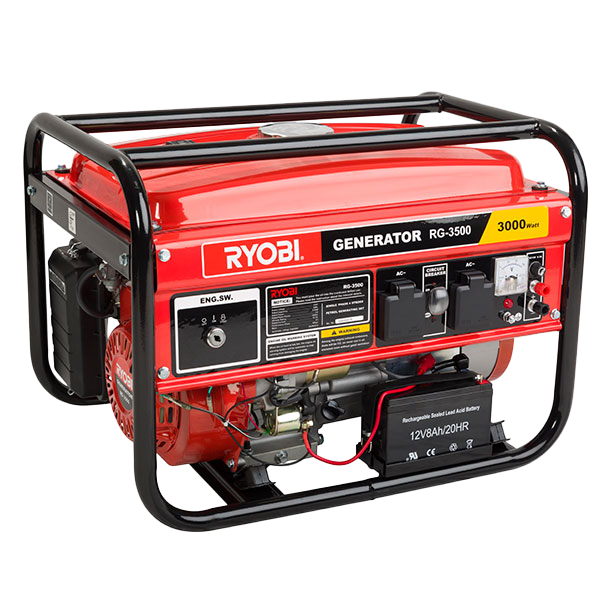
Safety tips:
- Only use a licenced electrician – generators need to be correctly installed. When connecting to your DB board, a changeover switch should be installed. You must always obtain a COC (Certificate of Compliance).
- Choose a suitable location – your generator emits dangerous fumes, so a well ventilated area is needed.
- Only use a good-quality heavy-duty extension lead with a 3-prong 16 amp plug.
- Earth your generator properly or else you run the risk of electrocution. Putting your generator on rubber car mats assists slightly with noise level, but connecting to an earth spike is very important.
- Do not overfill the tank and never refuel whilst your generator is running. Allow it to cool sufficiently before refuelling.
- You should never operate a generator in the wet/rain as this can lead to an electrical short circuit/malfunction.
Service & maintenance intervals
Note – Old fuel in the tank is a common cause of generator starting problems. If a generator is unlikely to be used for a long period of time, it is advisable to empty the fuel tank and carburettor either by using the drain (on some models) or run the generator until it is out of fuel.
Note – This schedule is based on the assumption that your generator will be used for its designed purpose. Sustained high-load, high-temperature operation or use in wet or dusty conditions will necessitate more frequent servicing.
- Service more frequently when used in dusty or wet areas.
- For commercial use, log hours of operation to determine proper maintenance intervals.
- If not used frequently, recharge the battery every 3 months.
- A major service is recommended every year or every 300 hours.
- Do not use a generator in unventilated areas.
| Item performed at every indicated month or hour interval, whichever comes first. | Before Each Use | First 20 Hours | Every 3 Months or 50 Hours | Every 6 Months or 100 Hours | |
|---|---|---|---|---|---|
| Engine Oil | Check | X | |||
| Change | X | X | |||
| Air Cleaner | Check | X | |||
| Clean | X | ||||
| Spark Plug | Clean/Adjust | X | |||
| Fuel Tank and Fitter | Clean | X | |||
Please read the provided operators and warranty manuals carefully prior to using your generator. Make particular reference to the Service and Maintenance Table supplied.
Product Comparison Chart
| Make & Model | RYOBI RG-950 |
RYOBI RG-1200 |
RYOBI RG-2100I |
RYOBI RG-2600I |
RYOBI RG-3200I |
RYOBI RG-2700 |
RYOBI RG-6900K |
GRIP SRGE6500E |
RYOBI RG-7000K |
RYOBI RG-7900K |
GRIP SRGE8500E |
RYOBI RG-10kVA |
|---|---|---|---|---|---|---|---|---|---|---|---|---|
| Maximum Power | 950 W | 2.1 kW | 2 100 W | 2 600 W | 3 200 W | 2.5 kW | 5.5 kW | 5.5 kW/5.5 kVA | 6.5 kW | 7.5 kW | 7.5 kW/7.5 kVA | 11.0 kW |
| Rated Power | 650 W | 1.0 kW | 1 750 W | 2 200 W | 2 800 W | 2.0 kW | 5.0 kW | 5.0 kW/5 kVA | 6.0 kW | 6.8 kW | 7.0 kW/7 kVA | 10.0 kW |
| Rated Current | 2.8 A | 4.35 A | 7.6 A | 9.6 A | 12.2 A | 8.7 A | 23.9 A | 21.75 A | 26 A | 29.5 A | 30.43 A | 43.5 A |
| DC Voltage | 12 V | 12 V | 12 V | USB 5 V | 12 V | 12 V | 12 V | 12 V | 12 V | 12 V | 12 V | 12 V |
| Fuel | Unleaded | Unleaded | Unleaded | Unleaded | Unleaded | Unleaded | Unleaded | Unleaded | Unleaded | Unleaded | Unleaded | Unleaded |
| Fuel Tank (Liters) | 4 | 6.5 | 4 | 5 | 10.5 | 12 | 25 | 25 | 25 | 25 | 25 | 25 |
| Engine Type | 2-stroke, air-cooled | Vertical OHV, 4-stroke, forced air-cooled, single cylinder | 4-stroke, forced air-cooled | 4-stroke, forced air-cooled | 4-stroke, forced air-cooled | 4-stroke, air-cooled | 4-stroke, air-cooled | 4-stroke, air-cooled | 4-stroke, air-cooled | 4-stroke, air-cooled | 4-stroke, air-cooled | 4-stroke, air-cooled |
| Displacement | 63 cc | 100 cc | 80 cc | 196 cc | 207 cc | 196 cc | 389 cc | 390 cc | 460 cc | 460 cc | 445 cc | 614 cc |
| Start System | Recoil pull start | Recoil pull start | Recoil pull start | Recoil pull start | Remote and key start | Push-button start | Push-button electric start | Push-button start | Push-button start | Push-button start | Push-button electric start | Key start |
| Estimated Runtime | 6 hours | 8 hours | 3.5 hours | 5 hours | 7 hours | 10 hours | 8 hours | 8 hours | 7 hours | 7 hours | 7 hours | 9 hours |
| Weight | 20.5 kg | 25 kg | 42 kg | 26 kg | 42 kg | 41.5 kg | 87 kg | 85 kg | 88 kg | 90 kg | 90 kg | 160 kg |
| Automatic Voltage Regulator (AVR) | No | Yes | Yes | Yes | Yes | Yes | Yes | Yes | Yes | Yes | Yes | Yes |

